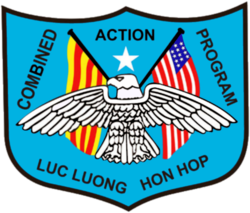Combined action program
| Combined Action Program | |
|---|---|

Seal of the Combined Action Program
|
|
| Active | 1965–1971 |
| Country | United States |
| Allegiance | Department of the Navy |
| Branch | United States Marine Corps |
| Type | Civic Action |
The Combined Action Program was a United States Marine Corps operational initiative implemented in the Vietnam War and proved to be one of the most effective counterinsurgency tools developed during that conflict. Operating from 1965 to 1971, this program was characterized by the placement of a thirteen-member Marine rifle squad, augmented by a U.S. Navy Corpsman and strengthened by a Vietnamese militia platoon of older youth and elderly men, in or adjacent to a rural Vietnamese hamlet. In most cases, the Popular Forces militia members (Nghia Quan) were residents of the hamlet who were either too young or too old to be drafted into the Army of the Republic of Viet Nam (ARVN) or the Regional Forces (Dia Phuong Quan). The entire unit of American Marines and Popular Forces militia members together was designated as a Combined Action Platoon (CAP).
The program was said to have originated as a solution to one Marine infantry battalion's problem of an expanding Tactical Area of Responsibility (TAOR). The concept of combining a squad of Marines with local (PFs) and assigning them a village to protect proved to be a force multiplier.
While the exact implementation varied with the stage of the war and local command variations, the basic model was to combine a Marine squad with local forces to form a village defense platoon. It was effective in denying the enemy a sanctuary at the local village level. The pacification campaign seemed to work under the CAP concept, and the Marines fully embraced it. Objectively, there is no solid proof that the CAP concept was a resounding success; however, subjectively the evidence suggests otherwise.
"Counterinsurgency operations and, in particular, the establishment of a foreign internal defense lends itself for the greatest utility of employing a CAP-style organization. Recent operations in Somalia, Haiti, and Bosnia suggest a CAP-style organization could accomplish the assigned mission." In Iraq and Afghanistan, the Marines reinstituted a variant of the CAP.
...
Wikipedia
